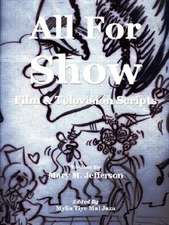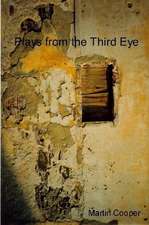What Are You Laughing At?: A Comprehensive Guide to the Comedic Event
Autor Dan O'Shannonen Limba Engleză Paperback – 5 sep 2012
Preț: 124.89 lei
Preț vechi: 213.63 lei
-42% Nou
Puncte Express: 187
Preț estimativ în valută:
23.90€ • 25.02$ • 19.82£
23.90€ • 25.02$ • 19.82£
Carte tipărită la comandă
Livrare economică 09-23 aprilie
Preluare comenzi: 021 569.72.76
Specificații
ISBN-13: 9781441162939
ISBN-10: 1441162933
Pagini: 272
Ilustrații: 171
Dimensiuni: 152 x 229 x 20 mm
Greutate: 0.52 kg
Ediția:New.
Editura: Bloomsbury Publishing
Colecția Continuum
Locul publicării:New York, United States
ISBN-10: 1441162933
Pagini: 272
Ilustrații: 171
Dimensiuni: 152 x 229 x 20 mm
Greutate: 0.52 kg
Ediția:New.
Editura: Bloomsbury Publishing
Colecția Continuum
Locul publicării:New York, United States
Caracteristici
Encourages analytical thinking through deconstruction andexperimentation, along with the tools for applying these methods tocomedy.
Notă biografică
Dan O'Shannon is currently co-executive producer for the ABC show Modern Family, previously working on other Emmy nominated shows such as Frasier and Cheers. O'Shannon has also lectured in classes at UCLA, USC, and taught a course on writing at Cleveland State University, where he holds an honorary doctorate.
Cuprins
INTRODUCTION
OVERVIEW
Common Comedy Theories
The Comedic Event
Documenting the Comedic Event
PART I: ELEMENTS OF CONTEXT: THE RECEPTION FACTORS
CHAPTER 1: THE RECEIVER AND HIS WORLD
1-1. A Comedy Frame of Mind
1-2. Early Reception Factors
1-3. Levels of Social Interaction
CHAPTER 2: ELEMENTS OF COMMUNICATION
2-1. Modes of Communication
2-2. Device and Specific Device
CHAPTER 3: VEHICLES
3-1. Vehicles
3-2. Vehicle-based Reception Factors
CHAPTER 4: LEVEL OF CONTROL AND IDENTIFYING THE SOURCE
4-1. Level of Control
4-2. Identifying The Source
PART II: THE INCONGRUOUS PICTURE
CHAPTER 5: FUNDAMENTAL COMPONENTS
5-1. The Receiver's Brain: Hard-wired for Comedy?
5-2. The Triangle
5-3. The Core Variables
CHAPTER 6: INCONGRUITY
6-1. Incongruity
6-2. Estimating Levels of Incongruity
6-3. Types of Incongruity
CHAPTER 7: COGNITIVE PROCESS
7-1. Cognitive Process: Overview
7-2. Level One: Straightforward Information
7-3. Level Two: Gap-filling
7-4: Level Three: Recontextualization
CHAPTER 8: VARIATIONS
8-1. Exploring the Four Corners of the Triangle
8-2. What are Practical Jokes?
CHAPTER 9: COMEDY AND ENTROPY
9-1. Sustaining the Laugh
9-2. Entropy
PART III: ENHANCERS AND INHIBITORS
CHAPTER 10: HOW COMEDIC INFORMATION TRIGGERS ENHANCERS AND INHIBITORS
10-1. Overview
10-2. On-going Social Needs: Superiority, Identification, and Inclusion
10-3. Aspects of Awareness
CHAPTER 11: ELEMENTS OF THE JOKE'S COMMUNICATION, STRUCTURE, AND CONTENT
11-1. Resuming the Chart: The Joke as a Whole
11-2. Elements of Communication and Structure
11-3. Elements of Content
SUMMING IT ALL UP
The Completed Chart
Final Thoughts and Acknowledgments
OVERVIEW
Common Comedy Theories
The Comedic Event
Documenting the Comedic Event
PART I: ELEMENTS OF CONTEXT: THE RECEPTION FACTORS
CHAPTER 1: THE RECEIVER AND HIS WORLD
1-1. A Comedy Frame of Mind
1-2. Early Reception Factors
1-3. Levels of Social Interaction
CHAPTER 2: ELEMENTS OF COMMUNICATION
2-1. Modes of Communication
2-2. Device and Specific Device
CHAPTER 3: VEHICLES
3-1. Vehicles
3-2. Vehicle-based Reception Factors
CHAPTER 4: LEVEL OF CONTROL AND IDENTIFYING THE SOURCE
4-1. Level of Control
4-2. Identifying The Source
PART II: THE INCONGRUOUS PICTURE
CHAPTER 5: FUNDAMENTAL COMPONENTS
5-1. The Receiver's Brain: Hard-wired for Comedy?
5-2. The Triangle
5-3. The Core Variables
CHAPTER 6: INCONGRUITY
6-1. Incongruity
6-2. Estimating Levels of Incongruity
6-3. Types of Incongruity
CHAPTER 7: COGNITIVE PROCESS
7-1. Cognitive Process: Overview
7-2. Level One: Straightforward Information
7-3. Level Two: Gap-filling
7-4: Level Three: Recontextualization
CHAPTER 8: VARIATIONS
8-1. Exploring the Four Corners of the Triangle
8-2. What are Practical Jokes?
CHAPTER 9: COMEDY AND ENTROPY
9-1. Sustaining the Laugh
9-2. Entropy
PART III: ENHANCERS AND INHIBITORS
CHAPTER 10: HOW COMEDIC INFORMATION TRIGGERS ENHANCERS AND INHIBITORS
10-1. Overview
10-2. On-going Social Needs: Superiority, Identification, and Inclusion
10-3. Aspects of Awareness
CHAPTER 11: ELEMENTS OF THE JOKE'S COMMUNICATION, STRUCTURE, AND CONTENT
11-1. Resuming the Chart: The Joke as a Whole
11-2. Elements of Communication and Structure
11-3. Elements of Content
SUMMING IT ALL UP
The Completed Chart
Final Thoughts and Acknowledgments
Recenzii
Comedy is an art, but there is comedy to be gained in treating it as a science. What Are You Laughing At? Is a discussion of the genre of many mediums in comedy, trying to define a broad topic which an vary person to person. Attempting to gain a better understanding of the concept of comedy, writer for many hit comedy sitcoms in the past few decades Dan O'Shannon presents an intriguing delve into psychology and sociology behind it all. What Are You Laughing At? Is a fine take on the meaning and purpose of comedy, highly recommended.
As hard as it would be to define "'the meaning of life', defining 'comedy' is harder. And somehow Dan O'Shannon does it in his insightful, comprehensive, and funny new book, What Are You Laughing At?: A Comprehensive Guide to the Comedic Event. I've been writing humor for 35 years and I learned stuff! If you're planning on a career in comedy all you will need is this book and a rubber chicken.
Creative individuals usually have difficulty explaining how they get their ideas. But O'Shannon's presentation of how comedy works in excellent and detailed. O'Shannon is certainly an expert at creating comedy, having written and produced television successes like Cheers, Frasier, and Modern Family. He confesses here, however, that in his job he does not use the model he describes here and that he did have scholarly help, which he praises and is thankful for. The result is a sophisticated model of humor that stands up quite well against more scholarly works like Matthew Hurley, Daniel Dennett, and Reginald Adams Jr.'s Inside Jokes (CH, Jan'12, 49-2983) and John Morreall's Comic Relief (CH, Sep'10, 48-0062). .This is a book for anyone curious about the nature of humor. Summing up: Highly recommended. All readers.
As hard as it would be to define "'the meaning of life', defining 'comedy' is harder. And somehow Dan O'Shannon does it in his insightful, comprehensive, and funny new book, What Are You Laughing At?: A Comprehensive Guide to the Comedic Event. I've been writing humor for 35 years and I learned stuff! If you're planning on a career in comedy all you will need is this book and a rubber chicken.
Creative individuals usually have difficulty explaining how they get their ideas. But O'Shannon's presentation of how comedy works in excellent and detailed. O'Shannon is certainly an expert at creating comedy, having written and produced television successes like Cheers, Frasier, and Modern Family. He confesses here, however, that in his job he does not use the model he describes here and that he did have scholarly help, which he praises and is thankful for. The result is a sophisticated model of humor that stands up quite well against more scholarly works like Matthew Hurley, Daniel Dennett, and Reginald Adams Jr.'s Inside Jokes (CH, Jan'12, 49-2983) and John Morreall's Comic Relief (CH, Sep'10, 48-0062). .This is a book for anyone curious about the nature of humor. Summing up: Highly recommended. All readers.
Descriere
This book presents a comprehensive guide to all the variables that can come into play when we come into contact with comedy.

























